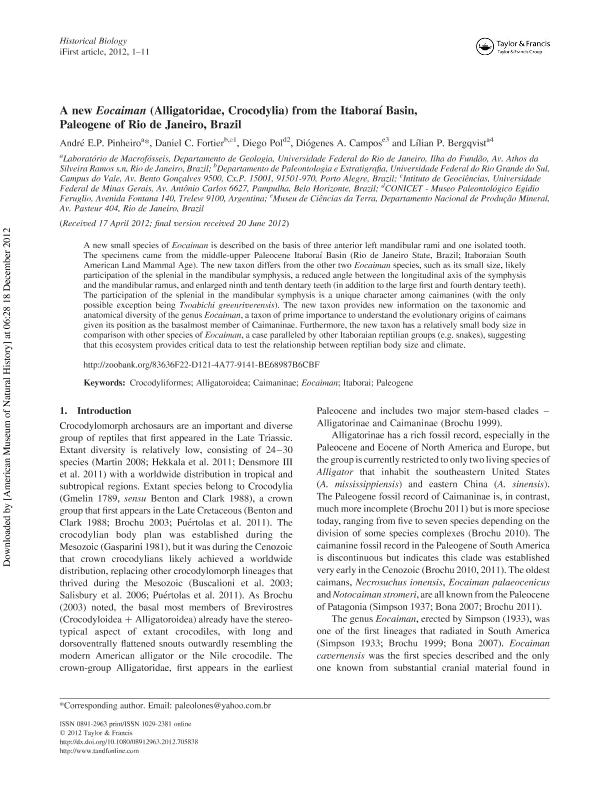Artículo
A new Eocaiman (Alligatoridae, Crocodylia) from the Itaboraí Basin, Paleogene of Rio de Janeiro, Brazil
Fecha de publicación:
05/2013
Editorial:
Taylor & Francis
Revista:
Historical Biology
ISSN:
0891-2963
Idioma:
Inglés
Tipo de recurso:
Artículo publicado
Clasificación temática:
Resumen
A new small species of Eocaiman is described on the basis of three anterior left mandibular rami and one isolated tooth. The specimens came from the middle-upper Paleocene Itabora ́ı Basin (Rio de Janeiro State, Brazil; Itaboraian South American Land Mammal Age). The new taxon differs from the other two Eocaiman species, such as its small size, likely participation of the splenial in the mandibular symphysis, a reduced angle between the longitudinal axis of the symphysis and the mandibular ramus, and enlarged ninth and tenth dentary teeth (in addition to the large first and fourth dentary teeth). The participation of the splenial in the mandibular symphysis is a unique character among caimanines (with the only possible exception being Tsoabichi greenriverensis). The new taxon provides new information on the taxonomic and anatomical diversity of the genus Eocaiman, a taxon of prime importance to understand the evolutionary origins of caimans given its position as the basalmost member of Caimaninae. Furthermore, the new taxon has a relatively small body size in comparison with other species of Eocaiman, a case paralleled by other Itaboraian reptilian groups (e.g. snakes), suggesting that this ecosystem provides critical data to test the relationship between reptilian body size and climate.
Palabras clave:
Crocodylia
,
Paleocene
,
Brazil
,
Evolution
Archivos asociados
Licencia
Identificadores
Colecciones
Articulos(CCT-CENPAT)
Articulos de CTRO.CIENTIFICO TECNOL.CONICET - CENPAT
Articulos de CTRO.CIENTIFICO TECNOL.CONICET - CENPAT
Citación
Pinheiro, André E. P.; Fortier, Daniel C.; Pol, Diego; Campos, Diógenes A.; Bergqvist, Lílian P.; A new Eocaiman (Alligatoridae, Crocodylia) from the Itaboraí Basin, Paleogene of Rio de Janeiro, Brazil; Taylor & Francis; Historical Biology; 25; 3; 5-2013; 327-337
Compartir
Altmétricas




